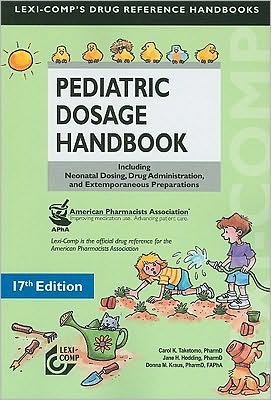Pediatric Dosage Handbook:
Search in google:
"Lexi-Comp's Pediatric Dosage Handbook, 17th Edition, continues as the most trusted dosing reference for neonates, infants, and children. This practical guide is organized in convenient sections, including an alphabetical listing of drugs, a comprehensive appendix of comparative charts, tables, and supporting information, and a therapeutic category and key word index." Each drug monograph provides up to 40 fields of pharmacology detail, including dosing, drug administration, and extemporaneous preparations. Other fields of interest include warnings, precautions, adverse reactions, drug interactions, patient information, and more. The Pediatric Dosage Handbook is the ideal point-of-care resource for medical professionals managing pediatric patients. Doody Review Services Reviewer:Vanessa Carroll, MD(Ochsner Clinic Foundation)Description:This is the 13th edition of a handbook that extensively addresses medications in children, focusing on usage, warnings, adverse reactions, drug interactions, mechanisms of actions, pharmacodynamics, pharmacokinetics, and nursing/patient information. The previous edition was published in 2004.Purpose:This book is intended as a practical and convenient guide for dosage and usage of medications in children. The objectives are worthy and certainly met by the authors.Audience:It is written for all pediatric healthcare providers. Medical students, residents, and staff physicians in almost all pediatric specialties will greatly benefit from this book. Features:The drug information is presented in an alphabetical list, using a simple and consistent format throughout. The entries include a pronunciation guide, safety issues, brand names, generic availability, usage, lactation, contraindications, warnings, adverse reactions, mechanism of action, pharmacodynamics, pharmacokinetics, patient/additional information, and references. This is valuable information in an easy to use format, which provides benefit to all healthcare providers regardless of level of training.Assessment:This is an essential desk reference for all healthcare providers. It contains vital information regarding usages and dosages of medications used in the care of neonates, infants, children, and adolescents. Its simple and thorough organization allows users to quickly ascertain information about the most commonly used pediatric drugs. With many competitors in this field, thisis the best pediatric medication reference book available. This edition adds lactation information, updates the monographs, and adds four new appendixes.
Preface 2Acknowledgments 4Editorial Advisory Panel 5About the Authors 10Description of Sections and Fields Used in This Handbook 11Definition of Age Group Terminology 14FDA Pregnancy Categories 15Symbols & Abbreviations Used in This Handbook 16Preventing Prescribing Errors 20FDA Name Differentiation Project: The Use of "Tall Man" Letters 22Alphabetical Listing of Drugs 25APPENDIX 1453Cardiology 1455Comparative Drug Charts 1484Conversion Tables 1512Cytochrome P450 Enzymes and Drug Metabolism 1513Dermatology 1522Endocrinology 1525Fluids, Electrolytes, and Nutrition 1529Growth and Development 1565Hematology / Oncology 1579Hepatology 1608Hotline Numbers 1609Infectious Diseases / Immunology 1610Laboratory 1672Neonatology 1682Nephrology 1683Neurology 1687Pulmonary 1697Therapeutic Drug Monitoring 1704Toxicology 1706Miscellaneous 1710Therapeutic Category & Key Word Index 1743
\ From The CriticsReviewer:Vanessa Carroll, MD(Ochsner Clinic Foundation)\ Description:This is the 13th edition of a handbook that extensively addresses medications in children, focusing on usage, warnings, adverse reactions, drug interactions, mechanisms of actions, pharmacodynamics, pharmacokinetics, and nursing/patient information. The previous edition was published in 2004.\ Purpose:This book is intended as a practical and convenient guide for dosage and usage of medications in children. The objectives are worthy and certainly met by the authors.\ Audience:It is written for all pediatric healthcare providers. Medical students, residents, and staff physicians in almost all pediatric specialties will greatly benefit from this book. \ Features:The drug information is presented in an alphabetical list, using a simple and consistent format throughout. The entries include a pronunciation guide, safety issues, brand names, generic availability, usage, lactation, contraindications, warnings, adverse reactions, mechanism of action, pharmacodynamics, pharmacokinetics, patient/additional information, and references. This is valuable information in an easy to use format, which provides benefit to all healthcare providers regardless of level of training.\ Assessment:This is an essential desk reference for all healthcare providers. It contains vital information regarding usages and dosages of medications used in the care of neonates, infants, children, and adolescents. Its simple and thorough organization allows users to quickly ascertain information about the most commonly used pediatric drugs. With many competitors in this field, thisis the best pediatric medication reference book available. This edition adds lactation information, updates the monographs, and adds four new appendixes.\ \








